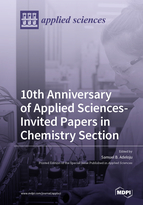10th Anniversary of Applied Sciences-Invited Papers in Chemistry Section
A special issue of Applied Sciences (ISSN 2076-3417). This special issue belongs to the section "Chemical and Molecular Sciences".
Deadline for manuscript submissions: closed (31 December 2020) | Viewed by 41963
Special Issue Editor
Interests: nanobiosensors; nanomaterials; conducting polymers; electroanalytical chemistry; environmental chemistry; microbial fuel cells
Special Issues, Collections and Topics in MDPI journals
Special Issue Information
Dear Colleagues,
Applied Sciences has reached a remarkable milestone this year by publishing its 10th volume of the journal, and to celebrate this special occasion, we have launched a special issue devoted to Chemistry entitled “The 10th Anniversary of Applied Sciences—Invited Papers in the Chemistry Section”.
This Special Issue will consist of comprehensive review and original research articles featuring important and recent developments or advabcements in all areas of chemisty. Authors who are well-known experts in their fields of study are invited to submit their contributions for this Special Issue up to the end of November 2020. The submitted papers can cover either experimental or theoretical aspects, or both, of all branches of chemistry and its subdisciplines. These also include research on how chemsitry is used for various applications in modern society. Subject areas include (but are not limited to): analytical chemistry, electrochemistry, environmental chemistry, inorganic chemistry, organic chemistry, physical chemistry, materials chemistry, etc. More details can be found at:
https://www.mdpi.com/journal/applsci/sections/applied_chemistry
We invite you to contribute a comprehensive review article or an original research paper for peer-review and possible publication in this Special Issue to commemorate the publication this year of the 10th volume of Applied Sciences.
Prof. Dr. Samuel Adeloju
Guest Editor
Manuscript Submission Information
Manuscripts should be submitted online at www.mdpi.com by registering and logging in to this website. Once you are registered, click here to go to the submission form. Manuscripts can be submitted until the deadline. All submissions that pass pre-check are peer-reviewed. Accepted papers will be published continuously in the journal (as soon as accepted) and will be listed together on the special issue website. Research articles, review articles as well as short communications are invited. For planned papers, a title and short abstract (about 100 words) can be sent to the Editorial Office for announcement on this website.
Submitted manuscripts should not have been published previously, nor be under consideration for publication elsewhere (except conference proceedings papers). All manuscripts are thoroughly refereed through a single-blind peer-review process. A guide for authors and other relevant information for submission of manuscripts is available on the Instructions for Authors page. Applied Sciences is an international peer-reviewed open access semimonthly journal published by MDPI.
Please visit the Instructions for Authors page before submitting a manuscript. The Article Processing Charge (APC) for publication in this open access journal is 2400 CHF (Swiss Francs). Submitted papers should be well formatted and use good English. Authors may use MDPI's English editing service prior to publication or during author revisions.






